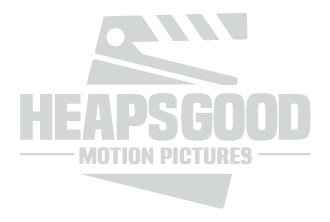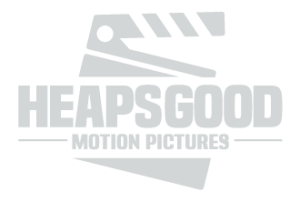Here I have had some time to experiment with a typical portrait / interview scenario with the simplest of tools and using what you have and what mist might have access to in the real world of filmmaking. The problem is always light. When you can sit down and experiment and find out how you can use your environment to best suit you situation, that is the best. Not in all job has one time to play around with such things, so it is a good idea to try at home, when one is not looking after kids or working on other projects. So, here goes a simple step by step process in finding out how to build a scene for your interview. I will note that setups are subjective and what might look fine to me won’t work for others. It’s all down to the old taste.
Step 1: Start in the Dark.

Here is the scene, set to F/2.8 @ 400 ISO on a 35mm (approx 50mm FOV on this camera) with just the ambient light and the curtains from the windows drawn shut. As you can obviously see, the exposure is low and we find it hard to see our subject (which is me) and the environment. This can be OK if you want mystery for you image, but you should really check out what needs to be in place first before delivering an underexposed image.
Step 2: Practicals. Is there a lamp you can use in your scene?

Practicals, AKA lights you can see in your scene. Is there already one in the background? Can you bring one to make some interest in the background? Try it and see how the scene starts to transform itself before your eyes!
Step 3: Natural light, why not open up a window ~ if there is one?

Now, just by opening up the window, we see a dramatic change in the levels of exposure in the room and we can begin to distinguish objects of interest in the room. For example, we can see some interesting shapes with the skateboards and the shelves, giving some depth and interest for the light to fall on. A good tip is to adjust the amount of opening there is with the curtain. You can really play around with how much light comes into the scene and that is an amazing free asset for you when building you picture.
Step 4: Light it up!

Here, in this example, I took away the back light, or ambient, so we can see what the introduced light does to my face. As you can see now, there is enough level that we can make out who this person is! It is good to check this out without the other lights disturbing your key light, as you can shape it to how you would like it. Sometimes, it can be difficult to see with the ambient light filling the scene. I like to do it this way, as I can give my eyes that pop they deserve.
Step 5: Bring it together.

Now our scene is starting to look alright. Not just because I’m holding up a big camera, but the light is giving a nice natural feel. The window light in the background gives us the feeling of window light and the practical light in the background is giving us depth and separation. Sitting at f/2.8 also helps give that depth and we are not pushing the camera past any ISO madness, as we are still on 400 ISO … that hasn’t changed. Look at how things start coming together! However, we are still not really finished. But, if you are in a pinch and have only one light, this might save your day in a 2 minute setup!
Step 6: Details.

Because I care about the small details, I don’t might spending that extra effort and minute to add in another little splash of love. In most cases, you will have some time to set up an extra light. If you don’t, your subject is a busybee! However, you can say: “this will make you look great.” and 9.5/10 times people go: “Great, do it, please!” So, you do it. You look at your scene once again and give it some details. Adding a kicker light that isn’t so noticeable can add so much to your image. Look, now the ear and cheek on my right side is illuminated, thus giving more shape. We are not loosing that definition or shadow, as the light is from a good angle behind, just to give that edge. Also, I put a 1/4 CTO gel on the light to copy the colour coming from the practical light in the background, aluring us to believe that that light is coming from the lamp in the backgound. Although, because the light is facing downwards, it is a little harder to believe that, if you look deeper into the image technically. But! If you don’t look at it that way, you kind of believe that is the light giving us that kicker. Thus, movie magic!
The next image is an example when you overdo it with the kicker:

Step 7: Try something else

Sometimes people love to wear sunnies for an interview and that is great. However, your setup is going to be given away! So, it might be good to look at your scene again and see what you can do to help mitigate the obviousness of your lighting set up. However, in the example above, we see not so much of the light, as I am shooting through a big round diffusion. But, here, you can tell obviously that this is lit. If I was to correct this, I would open up the window in the background more and pan the camera a little towards that window, to give more situation belief. Or whatever you feel tastes good!
Tips: Watch out for stray lights!

Here is something I see often in interview and it bugs me to the point of not watching it at all, unless it is really interesting! Top Down lights, or regualr house lights make people look like animals, criminals or just been punched whilst sleeping. Observe the right eye and see how much the recess is prominent and the brow is shadowing. Depending on your set up, try and block or turn off all lights from above. Again, start in the dark and build your way up.

If you don’t want to have so much contrast in your features, you can add a reflector or another light and flatten out your subjects face. Here you can also experiment with ratios, like the 8:1 or 2:1 contrast ratio. Season by taste. Already, the image feels different just by adding a very small light source only an arms length away. Again, be careful about mixing light sources, especially LED! Try and get a matching set or at least from the same manufacture! Otherwise you will get a colour cast mess! And that look bad, even in RAW! Don’t do it.
Step 8: Time to have fun!

Once you have completed your setup, it is time to film and have fun! You don;t need to change anything, just concertrate on your clients / subjects best performance and help them through it! That is, of course, if you are working solo, which most who will be reading this will be probably doing in the first few jobs. It is great fun once you can trust you camera is capturing what is should, then the rest is pretty straightforward! Enjoy!
Setup that I used: 1. Picture: a little daylight balanced LED Fresnel from Litepanels, give enough punch through a 200kr reflector diffusion foldable. This gives me the keylight that I desire. 2. Picture: just next to the monitor and the speaker, is another LED Fresnel with some barn doors to shape the light for the kicker at about the same height as the lamp in the background, as well as gelled to match the colour temp, too. And that is it ! So simple!



I hope that this little demonstrations was helpful in someway? Starting in the dark helps wonders, especially if you need to see what your light sources are doing to your image. If you have the luxury of an external monitor, which you can swivel around to see yourself, that is the best. If not, you can send an HDMI cable to a tv or monitor and monitor yourself that way, as an idea! If not, you can just take photos or screengrabs of each step to track your process, like I have in this little demonstration. It costs you nothing and gives you refinement. Also, you can experiment on looks that you enjoy looking at and you gain experience which you can take out on the field and earn yourself a bucket of that tasty premium chocolate vegan icecream that tastes so yum!
That is it from me, thanks for reading! Ciao!
Patrick

